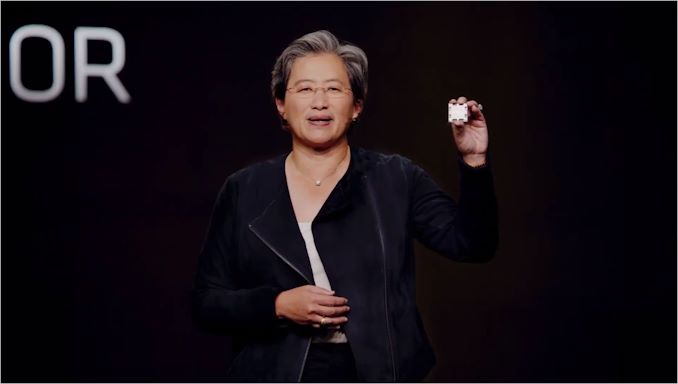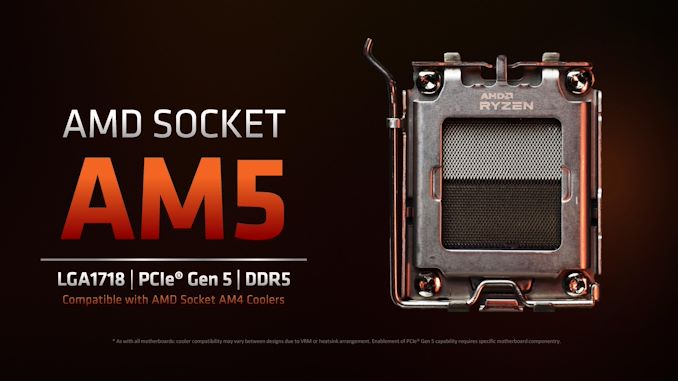CES 2022: AMD’s Next-Gen AM5 Platform to Have Long Term Support
by Dr. Ian Cutress on January 7, 2022 9:00 AM EST- Posted in
- CPUs
- AMD
- Trade Shows
- AM4
- Lisa Su
- Zen 4
- CES 2022
- AM5
- Ryzen 7000

One of the key aspects of AMD’s offering in the consumer desktop space is the longevity of its socket and platform. Throughout the years, AMD has leveraged a single socket for multiple generations, providing users the ability to keep the same motherboard year in and year out, while the competition changes the socket every couple of generations at best. To keep that mantra, AMD has stated that its next-generation platform coming later this year, AM5, will also be a multi-generational platform.
Going back in AMD’s history we can see just how long various platforms have lasted, from first processor launch to last processor launch:
- Socket 939 from 2004 to 2006
- AM2/2+ socket from 2006 to 2009
- AM3/3+ socket from 2009 to 2013
- FM2/2+ socket from 2012 to 2015
- AM4 socket from 2016 to 2021
- AM5 socket from 2021 to ...
Within that time there have been chipset updates to allow for better IO, however usually the socket change has happened because of DDR version changes, interconnect, and PCIe. In this instance, the move from AM4 to AM5 comes with a change from DDR4 to DDR5 and PCIe 4.0 to PCIe 5.0.
In a roundtable with Dr. Lisa Su, the question was asked about how long AM5 would be around – now that AMD has a sustainable position again in the desktop, and by many measures a leading position, would AMD continue its tradition of longer-lived desktop platforms. Dr. Su stated that AM4 ‘has been good for the community and … it’s been good for us as well’. She confirmed that a change was required with the new standards, but on strategy it was put that ‘I don’t have an exact number of years but I would say that you should expect that AM5 will be a long-lived platform as AM4 has been’. Dr. Su also stated that even with the introduction of AM5, the company expects AM4 to stay in the marketplace for some years, with overlap between the two depending on the market.
For users wondering how far AM5 can go before it needs to change again, it’s worth looking at roadmaps for the two usual elements that cause socket updates: memory and PCIe. We’re only just on the transition to DDR5, and DDR6 is a long way away – in a recent Samsung presentation, for example, it listed DDR6 as a 2028 technology. Similarly with PCIe 5.0, the same presentation puts PCIe 6.0 as a 2026 technology, and PCIe 7.0 as a 2029 technology. So unless AMD wants to increase the pin count on the CPUs for more memory channels or more PCIe lanes, the PCIe 5.0+DDR5 combination looks set until at least 2026.











42 Comments
View All Comments
ikjadoon - Friday, January 7, 2022 - link
Customary "screw your fragile chipsets, Intel". Can't believe some early 2018 AMD X470 motherboards can run 4 (!) generations of AMD CPUs and Intel can *barely* support two generations of CPUs.The most pathetic Intel chipsets in recent memory:
Z87 / Z97: only supported Haswell and Haswell "Refresh"
Z370 / Z390: only supported Coffee Lake and Coffee Lake "Refresh"
If anyone bought these chipsets, their CPU support went from "the launch CPUs" to "the launch CPUs with +100 MHz stock clock and maybe another two cores". It's a real poor way to treat your customers, Intel.
Intel motherboards are akin to flagship Android phones that lose feature support after 1-2 Android OS updates. Chipzilla will smite you for even asking if a 3rd update is even "possible".
LGA1700: this is its final year of existence and it only come out hardly two months ago. LGA1700 will never support a 2023 Intel CPU. We get Alder Lake and Raptor Lake.
ikjadoon - Friday, January 7, 2022 - link
Well, the final year of LGA1700 V1.Waiting for 2023's LGA1700 V2 that is "electrically incompatible" with LGA1700 V1.
shabby - Friday, January 7, 2022 - link
Lol yup typical intel, moves pins around so you can't reuse the mobo.Morawka - Sunday, January 9, 2022 - link
and increase the price 25% over last gen.edzieba - Friday, January 7, 2022 - link
"Can't believe some early 2018 AMD X470 motherboards can run 4 (!) generations of AMD CPUs and Intel can *barely* support two generations of CPUs."Good for that handful of models, but for the majority of AM4 motherboards CPU combability is limited to 2/3 CPU generations, and sometimes you need to switch BIOSes between generations due to BIOS capacity limits so not necessarily able to POST all generations on the same BIOS version. Thus you end up having to consult an arcane combability matrix (e.g. https://hexus.net/media/uploaded/2020/8/72e00246-c... ), as well as sometimes needing to find an older CPU in order for the board to POST in order to flash the BIOS to allow a newer CPU to POST, rather than the simpler "any motherboard and any CPU within these two generations are compatible".
8x and 9x chipsets also technically supported Broadwell, though that was admittedly a limited release.
"Intel motherboards are akin to flagship Android phones that lose feature support after 1-2 Android OS updates. Chipzilla will smite you for even asking if a 3rd update is even "possible"."
except software support continues long after newer CPUs are released, e.g. Z270 is still supported with software updates, and even many 1xx series boards have drivers available for Windows 11 (contemporaneous Bulldozer boards? Definitely not).
MrTeal - Friday, January 7, 2022 - link
AM3+ Bulldozer boards might have been what AMD had available in 2015 when Skylake launched, but that 800/900 series chipset and it's DDR3 RAM was already 5 years old at that point and everyone knew it was EOL since AMD announced in 2013 they weren't releasing more desktop FX processors. If you bought a 900 series board and FX CPU in 2015/2016 you did it because they were basically giving them away, not because you expected a solid upgrade path out of it.artk2219 - Sunday, January 9, 2022 - link
They were selling fx 8320e's with fx970 motherboards for sub 100 around 2014 through 2016. Granted they weren't bleeding edge or awesome, they still were plenty good for general usage computers, intro to mid level gaming rigs, fileservers, and basic vm hosts.Alexvrb - Saturday, January 8, 2022 - link
Support isn't a limitation of the chipsets, though. Board manufacturer support is key. The BIOS size limitations are also a manufacturer imposed limitation. In many cases they'd rather sell you a new board!thestryker - Friday, January 7, 2022 - link
I'm assuming you're just ranting for the sake of ranting, but just in case you're not the chipset shift is due to the massive number of SKUs Intel ships and the OEMs they're accountable to. For whatever reason (I'm not familiar enough, and nothing I can do will change it) BIOS storage is still relatively tiny which limits the amount of processor support, especially with the UEFI interfaces etc also vying for space.Perspective: There are currently 29 Alder Lake desktop parts (including the KS) versus 13 Zen 3 desktop parts (including OEM and 3D).
t.s - Wednesday, January 12, 2022 - link
Yeah, right. Like LGA1151 vs LGA1151(v2) that use exact same pin and you can, factually, use 1151 board for coffeelake CPU (1511v2), right? Lol.